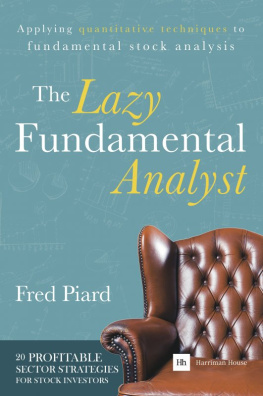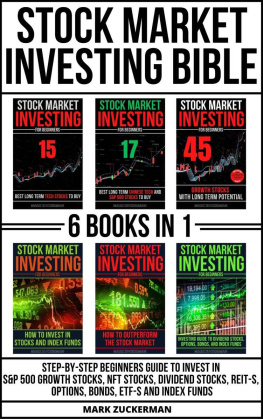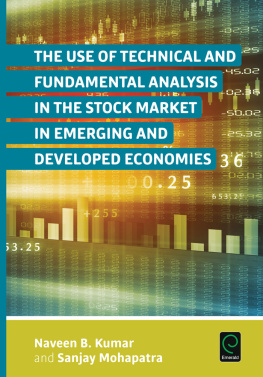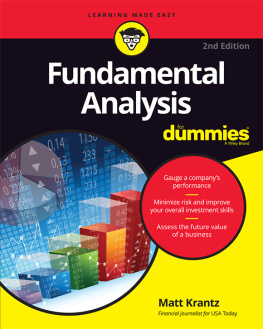Fred Piard - The Lazy Fundamental Analyst: Applying Quantitative Techniques to Fundamental Stock Analysis
Here you can read online Fred Piard - The Lazy Fundamental Analyst: Applying Quantitative Techniques to Fundamental Stock Analysis full text of the book (entire story) in english for free. Download pdf and epub, get meaning, cover and reviews about this ebook. year: 2014, publisher: HarrimanHouse, genre: Business. Description of the work, (preface) as well as reviews are available. Best literature library LitArk.com created for fans of good reading and offers a wide selection of genres:
Romance novel
Science fiction
Adventure
Detective
Science
History
Home and family
Prose
Art
Politics
Computer
Non-fiction
Religion
Business
Children
Humor
Choose a favorite category and find really read worthwhile books. Enjoy immersion in the world of imagination, feel the emotions of the characters or learn something new for yourself, make an fascinating discovery.
- Book:The Lazy Fundamental Analyst: Applying Quantitative Techniques to Fundamental Stock Analysis
- Author:
- Publisher:HarrimanHouse
- Genre:
- Year:2014
- Rating:4 / 5
- Favourites:Add to favourites
- Your mark:
- 80
- 1
- 2
- 3
- 4
- 5
The Lazy Fundamental Analyst: Applying Quantitative Techniques to Fundamental Stock Analysis: summary, description and annotation
We offer to read an annotation, description, summary or preface (depends on what the author of the book "The Lazy Fundamental Analyst: Applying Quantitative Techniques to Fundamental Stock Analysis" wrote himself). If you haven't found the necessary information about the book — write in the comments, we will try to find it.
Fred Piard: author's other books
Who wrote The Lazy Fundamental Analyst: Applying Quantitative Techniques to Fundamental Stock Analysis? Find out the surname, the name of the author of the book and a list of all author's works by series.
The Lazy Fundamental Analyst: Applying Quantitative Techniques to Fundamental Stock Analysis — read online for free the complete book (whole text) full work
Below is the text of the book, divided by pages. System saving the place of the last page read, allows you to conveniently read the book "The Lazy Fundamental Analyst: Applying Quantitative Techniques to Fundamental Stock Analysis" online for free, without having to search again every time where you left off. Put a bookmark, and you can go to the page where you finished reading at any time.
Font size:
Interval:
Bookmark:

HARRIMAN HOUSE LTD
18 College Street
Petersfield
Hampshire
GU31 4AD
GREAT BRITAIN
Tel: +44 (0)1730 233870
Email: enquiries@harriman-house.com
Website: www.harriman-house.com
First published in Great Britain in 2014
Copyright Harriman House
The right of Fred Piard to be identified as the Author has been asserted in accordance with the Copyright, Design and Patents Act 1988.
ISBN: 9780857194510
British Library Cataloguing in Publication Data
A CIP catalogue record for this book can be obtained from the British Library.
All rights reserved; no part of this publication may be reproduced, stored in a retrieval system, or transmitted in any form or by any means, electronic, mechanical, photocopying, recording, or otherwise without the prior written permission of the Publisher. This book may not be lent, resold, hired out or otherwise disposed of by way of trade in any form of binding or cover other than that in which it is published, without the prior written consent of the Publisher.
No responsibility for loss occasioned to any person or corporate body acting or refraining to act as a result of reading material in this book can be accepted by the Publisher, by the Author, or by the employer(s) of the Author.
www.facebook.com/harrimanhouse
@harrimanhouse
www.linkedin.com/company/harriman-house
www.harriman-house.com
The information provided in this book is for educational purposes only. It is not investment advice. Before deciding to invest in financial markets you should carefully consider your investment objectives, level of experience and risk appetite. The possibility exists that you could sustain a loss of some or all of your initial investment. You should seek advice from an independent financial advisor if you have any doubts.
All products, ETPs, indexes, tools and websites quoted in this book are the property and trademarks of their respective issuers. This work provides information about various investment methods. It does not constitute an offer, a financial promotion or a solicitation to purchase or sell any financial instruments.
No representation is being made that any investor will achieve results similar to those discussed here. The past performance of a system or methodology is not necessarily indicative for the future. The results presented in this book are mostly based on simulations. They have been made as realistic as possible. However there is a risk of errors from the data, software and the human operator.
CFTC rule 4.41 hypothetical or simulated performance results have certain limitations. Unlike an actual performance record, simulated results do not represent actual trading. Also, since the trades have not been executed, the results may have under- or overcompensated for the impact, if any, of certain market factors, such as lack of liquidity. Simulated trading programs in general are also subject to the fact that they are designed with the benefit of hindsight. No representation is being made that any account will or is likely to achieve profit or losses similar to those shown.
Fred Piard gained extensive experience in the software industry, information systems consulting and marketing before discovering an interest in the financial markets. Self-taught in this field, he puts into practice what he learnt from his previous activities to build his own methodology. From his years in research he has the ability to combine a systemic point of view and an analytic approach. As a software architect he knows that the things that work the best in the long term are the simplest. As a consultant he has experienced the real economy through various sectors: energy, banking, health care, manufacturing and public administration. And he has learned from marketing that human group behaviour can sometimes be modelled, but never predicted. Fred provides systematic portfolio strategies for investors and professionals. His proprietary library of models on themes and sectors can be personalised for specific requirements. He has a PhD in computer science, an MSc in software engineering and an MSc in civil engineering.
This book contains a collection of investing strategies based on the application of quantitative analysis to fundamental factors. The strategies are classified by sector and market capitalisation (for the latter, the indexes used are: S&P 500, Russell 2000 and DJ 30).
All the strategies share some common characteristics:
- They are the result of an extensive statistical study on 15 years of historical data, and are also validated by common sense.
- They are 100% fundamental: no use is made of chart analysis or technical indicators.
- They use only US stocks and ETFs. The concepts may well work in other markets but no representation is made about the expected results.
This book was written for anyone looking for simple, effective and low-risk investing strategies. The strategies described in the following pages can be managed in just a few minutes per month, making them suitable, for example, for investors with a full-time job.
The book is designed to be short, simple and actionable. No specific background in finance or statistics is needed. However, the understanding and implementation of the strategies needs a logical mind and the ability to feel comfortable with browsing online financial data sources.
The book consists of three parts.
The first part gives the information that readers need to understand how strategies have been designed and evaluated. It also details a portfolio protection method that may be added to any stock strategy to minimise the impact of market downturns.
The second part of the book, and the most important, is organised by 10 sectors. For each sector a strategy is proposed for large capitalisations (companies in the S&P 500 Index) and another one for small capitalisations (companies in the Russell 2000 Index). Mega caps (DJ 30 companies) are treated independently in a separate chapter. Each strategy is then compared to specialised sector indexes.
The final part shows some applications of the strategies introduced in the second part, in particular mixing strategies and top-down analysis.
My first active experience in the financial market was to buy shares in a company and a tracker. Then I forgot them for three years. I was lucky enough that my profit on the company just about offset my loss on the tracker but I was aware that it was just luck. So I decided to follow the People Who Know. I tried half a dozen paid services. The result of my follow-the-gurus period was no better than when I started.
The next stage was to study some technical indicators and patterns, buy software with configurable trading signals, and have a go at day trading. It involved a lot of time and stress. It also conflicted with my lifestyle I like the idea of putting money to work for ones life, not the opposite.
I found a better way when I began to scan with screeners and use simulation tools on the history of fundamental and technical data for thousands of stocks and ETFs. I discovered that it was possible to find good strategies that involved trading just once a month; these strategies ignored charts and the news, and removed much of the doubt and emotion.
Font size:
Interval:
Bookmark:
Similar books «The Lazy Fundamental Analyst: Applying Quantitative Techniques to Fundamental Stock Analysis»
Look at similar books to The Lazy Fundamental Analyst: Applying Quantitative Techniques to Fundamental Stock Analysis. We have selected literature similar in name and meaning in the hope of providing readers with more options to find new, interesting, not yet read works.
Discussion, reviews of the book The Lazy Fundamental Analyst: Applying Quantitative Techniques to Fundamental Stock Analysis and just readers' own opinions. Leave your comments, write what you think about the work, its meaning or the main characters. Specify what exactly you liked and what you didn't like, and why you think so.










